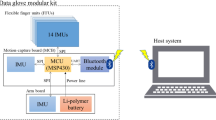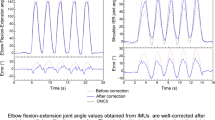Abstract
The aim of this paper is to present a method for assessing joint angles in a human hand: a method suitable for the calibration of an instrumented glove. The method is based on an optical tracking device and an inverse-kinematic model of the human hand. It requires only one reflective marker to be attached to each finger and three on the dorsal aspect of the hand in order to assess angles in finger joints. A further three markers are needed to calculate angles in thumb joints. Joint angles assessed through inverse kinematics and with the calibrated glove were validated against reference angles calculated from the centers of rotation of the joints while measuring the finger movements with multiple markers. In fingers, the mean difference between the reference angles and the angles assessed by the glove did not exceed ±7° when the proposed model-based method was used to calibrate the glove. For the thumb the mean error did not exceed ±5° when the reference method was used to calibrate the glove.
Similar content being viewed by others
Abbreviations
- D-H:
-
Denavit-Hartenberg
- DOF:
-
Degrees of freedom
- MCP:
-
Metacarpophalangeal joint
- PIP:
-
Proximal interphalangeal joint
- DIP:
-
Distal interphalangeal joint
- CMC:
-
carpometacarpal joint
- IP:
-
Interphalangeal joint
- CoR:
-
Center(s) of rotation
- f-e:
-
Flexion–extension
- ab-ad:
-
Abduction–adduction
References
Allevard T, Benoit E and Foulloy L (2005). Dynamic gesture recognition using signal processing based on fuzzy nominal scales. Measurement 38(3): 303–312
Bernardin K, Ogawara K, Ikeuchi K and Dillmann R (2005). A sensor fusion approach for recognizing continuous human grasping sequences using hidden Markov models. IEEE Trans Robot Autom 21(1): 47–57
Bicchi A (2000). Hands for dexterous manipulation and robust grasping: a difficult road toward simplicity. IEEE Trans Robot Autom 9(4): 432–443
Buchholz B, Armstrong T and Goldstein S (1992). Anthropometric data for describing the kinematics of the human hand. Ergonomics 35(3): 261–273
Chang L,Matsuoka Y (2006) A kinematic thumb model for the ACT hand. In: Proceedings of international conference on robotics and automation. Orlando, FL, pp 1000–1005
Chang L, Pollard N (2006) Constrained least-squares optimization for robust estimation of center of rotation. J Biomech 40(6):1392–1400
Denavit J and Hartenberg R (1955). A kinematic notation for lower-pair mechanisms based on matrices. J Appl Mech 22: 215–221
Dipietro L, Sabatini A and Dario P (2003). Evaluation of an instrumented glove for hand-movement acquisition. J Rehabil Res Dev 40(2): 179–190
Gamage SHU and Lasenby J (2004). New least squares solution for estimating the average centre of rotation and the axis of rotation. J Biomech 35(1): 87–93
Halvorsen K, Lesser M and Lundberg A (1999). A new method for estimating the axis of rotation and the center of rotation. J Biomech 32(11): 1221–1227
Kamper D, Cruz E and Siegel M (2003). Stereotypical fingertip trajectories during grasp. J Neurophysiol 90(6): 3702–3710
Klopcar N and Jadran L (2005). Kinematic model for determination of human arm reachable workspace. Meccanica 40(2): 203–219
Kramer J (1996). Determination of thumb position using measurements of abduction and rotation. US Patent 5: 482,056
Laszlo L and Gabor S (2003). Dynamics of digital force control applied in rehabilitation robotics. Meccanica 38(2): 213–226
MacKenzie L and Iberall T (1994). The grasping hand. Elsevier Science, Amsterdam
Miyata N, Kouchi M, Kurihara T, Mochimaru M (2004) Modeling of human hand link structure from optical motion tracking data. In: Proceedings of international conference on intelligent robots and systems. Sendai, Japan, pp 2129–2136
Okamura A, Smaby N, Cutkosky M (2000) An overview of dexterous manipulation. In: Proceedings of international conference on robotics and automation San Francisco, CA, pp 255–262
Sciavicco L, Siciliano B, (2002) Modelling and control of robot manipulators. Springer-Verlag
Sturman D and Zeltzer D (1994). A survey of glove-based input. IEEE Comput Graph Appl 14(1): 30–39
Vamplew P (1996) Recognition of sign language using neural networks. Ph.D. Thesis, School of Computing, University of Tasmania
Veber M, Bajd T, Munih M (2006) Assessment of finger joint angles and calibration of instrumental glove. In: Advances in robot kinematics. Ljubljana, Slovenia
Williams N, Penrose J, Caddy C, Barnes E, Hose D and Harley P (2000). A goniometric glove for clinical hand assessment construction, calibration and validation. J Hand Surg 25(2): 200–207
Zhang X, Lee S-W and Braido P (2003). Determining finger segmental CoR in flexion-extension based on surface marker measurement. J Biomech 36(8): 1097–1102
Author information
Authors and Affiliations
Corresponding author
Rights and permissions
About this article
Cite this article
Veber, M., Bajd, T. & Munih, M. Assessing joint angles in human hand via optical tracking device and calibrating instrumented glove. Meccanica 42, 451–463 (2007). https://doi.org/10.1007/s11012-007-9064-8
Received:
Accepted:
Published:
Issue Date:
DOI: https://doi.org/10.1007/s11012-007-9064-8




